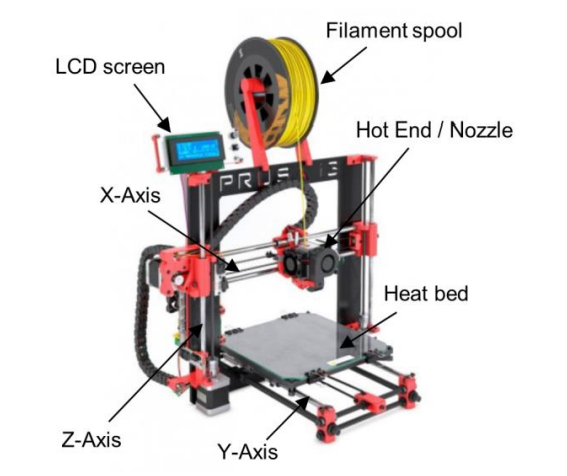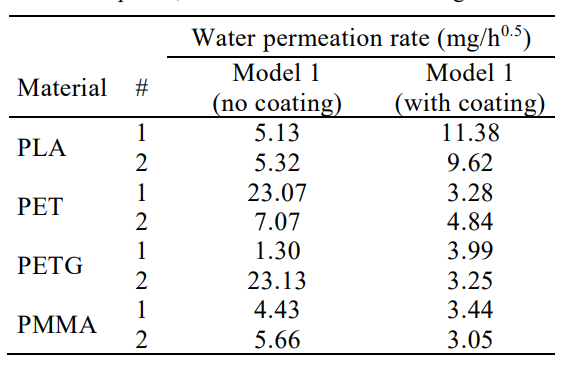In ‘3D printed capsules for self-healing concrete applications,’ researchers are exploring the world of self-healing materials further, with the creation of macro-capsules that can actually be filled with a variety of different agents to repair defects like cracking in concrete. For this study, they 3D printed tubular capsules and then filled them with two different types of chemicals—either polyurethane resin or liquid sodium silicate.
The approach shows promise, and it makes sense. The capsules (either micro- or macro-) break upon contact with a defect and then repair it. Previous research has examined encapsulation techniques—and some have been successful. Other researchers have created:
- Hollowed glass tubes
- Ceramic tubes produced by phase-inversion spinning
- Cementitious capsules produced by extrusion
- Polymeric capsules produced by extrusions

Model 1 capsules: a) printing of the first capsule end sealing and its shell; b) print is interrupted, capsule is filled and then print is resumed in order to realize the end sealing; c) 3D printed capsules, filled and with both ends sealed (from left to right PMMA, PET, PLA, PETG); d) coating application and e) capsule are rolled in the sand in order to improve their bonding with the cementitious matrix.
For this study, a Prusa I3 Hephestos 3D printer was used, set up with a 0.40 mm diameter nozzle. The team tried four different materials:
- PLA
- PET
- PET-G
- PMMA
The researchers evaluated whether the sample capsules were watertight, as this was a subject of ‘paramount importance’ for effective self-healing capsules. They tried filling the capsules with water, and then offered numerous variations, such as coated, not coated, without sealed ends, and more.
“Except in the case of PLA, the application of the external coating resulted in an overall reduction of the water absorption rate and an increased repeatability in the results, as in the case of the PET and PETG where the results were significantly different and most likely governed by the printing and layer adhesion defects,” stated the researchers.
The team then began to investigate the reaction of the capsules to a ‘harsh cementitious environment.’ With the Model 1 capsules, the sodium silicate was still viable for self-healing. Model 2 capsules were tested as the team evaluated the water loss over time, which was visible.
“Both models, when filled with the healing agents suitable for their characteristic features, showed satisfactory results in terms of mechanical recovery and spreading of the healing agent on the crack faces,” concluded the researchers. “This last feature suggests a good self-sealing ability, which is very important for preventing the ingress of harmful substances inside the fractured matrix. This aspect will be further investigated through tests aimed to assess self-sealing and durability-related features, such as water permeability and absorption tests.
“These positive results show a good potential of the proposed capsule-based system for structural applications. This work served as proof of concept of the use of Additive Manufacturing to produce self-healing encapsulated system, by using simple tubular capsules for the sake of comparison of extensively investigated system. Further improvements can be envisaged through the optimization of the capsule shape, for which the 3D printing technology offers virtually unlimited tailoring possibilities.”
Our world continues to grow smarter day by day, and often in the most surprising of places. While electronics (and especially robotics) are a logical area for smart devices, many others are up and coming, to include 4D printed materials which can morph according to their environment. Self-healing materials are another interesting element also, from materials that can fix shoes that are wearing out, to gel, and other self-healing structures. What do you think of this news? Let us know your thoughts! Join the discussion of this and other 3D printing topics at 3DPrintBoard.com.

Spreading of the liquid sodium silicate (left) and the PU foam (right) on the crack faces. The
area covered by the sodium silicate was colored in cyan in order to highlight its spreading region.
Subscribe to Our Email Newsletter
Stay up-to-date on all the latest news from the 3D printing industry and receive information and offers from third party vendors.
Print Services
Upload your 3D Models and get them printed quickly and efficiently.
You May Also Like
The Dental Additive Manufacturing Market Could Nearly Double by 2033, According to AM Research
According to an AM Research report from 2024, the medical device industry, specifically in dentistry, prosthetics, and audiology, is expected to see significant growth as these segments continue to benefit from...
Heating Up: 3D Systems’ Scott Green Discusses 3D Printing’s Potential in the Data Center Industry
The relentless rise of NVIDIA, the steadily increasing pledges of major private and public investments in national infrastructure projects around the world, and the general cultural obsession with AI have...
AM Research Webinar Explores Continuum’s Sustainable Metal Additive Manufacturing Powders
Metal additive manufacturing (AM) powder supplier Continuum Powders is working to develop solutions that empower industries to reduce waste and optimize their resources. An independent life cycle assessment (LCA) of...
3D Printed Footwear Startup Koobz Lands $7.2M in Seed Round
California-based Koobz is focused on reshoring the U.S. footwear supply chain with advanced manufacturing processes, including 3D printing. The startup just announced that it has added $6 million to its...



































